
Enhancing mobile video playback: Lessons from a real-world GStreamer project

Written by
FluendoNovember 13, 2025
This article presents a comprehensive overview of a recent consulting project focused on diagnosing and resolving video playback quality issues in a mobile application utilizing GStreamer for real-time video streaming. The insights and methodologies described here are meant to inform and guide professionals addressing similar challenges in the domain of mobile media streaming.
Understanding the challenge
The project centered on a mobile application that exhibited suboptimal video playback quality on select devices, despite leveraging a robust media framework. Notably, certain widely used Android models demonstrated visual artifacts and considerable playback latency, negatively impacting the user experience. The primary objective was to restore consistent, high-quality, and low-latency video streaming across the entire device spectrum.
Investigation and methodology
The diagnostic process commenced with a systematic comparison of video playback performance across multiple devices. It was observed that while some devices delivered flawless playback, others consistently exhibited artifacts and latency, even under identical streaming conditions. Further analysis revealed that the underlying cause was the inconsistent selection of the hardware video decoder within the media pipeline. Additionally, it was noted that the official application provided by the camera manufacturer employed a different network transport protocol, resulting in a more stable streaming experience.
Solutions implemented
In response to the findings, a series of targeted modifications was introduced. The media pipeline was reconfigured to ensure explicit selection of the hardware video decoder on devices where it was not being automatically utilized. This adjustment was achieved either by implementing device-specific logic or by detecting the absence of hardware acceleration and enforcing its use. Furthermore, the network transport protocol for video streaming was aligned with the approach used by the official application, resulting in improved connection reliability and playback stability. Following these interventions, video playback quality on previously affected devices was restored to a level consistent with the best-performing models.
Additional insights and recommendations
Several broader recommendations emerged from this engagement. Upgrading to the latest versions of the media framework is strongly advised, as recent releases have introduced significant improvements in codec detection and device compatibility. Additionally, selecting cameras that support advanced features such as retransmission and forward error correction can further enhance stream reliability and quality. Optimal results were achieved with asynchronous video sinks under stable network conditions; however, in scenarios characterized by network jitter, careful adjustment of synchronization parameters may be necessary.
Key takeaways
- It is essential to verify the selection of hardware decoders across all target devices when implementing video playback solutions.
- Employing reliable network transport protocols, such as TCP, can significantly improve streaming stability, particularly in mobile environments.
- Maintaining up-to-date software frameworks ensures access to the latest enhancements in codec handling and device support.
- Pipeline parameters should be carefully tuned to accommodate the specific characteristics of the data source and prevailing network conditions.
Conclusion
This engagement underscores the importance of a systematic and analytical approach to resolving media streaming challenges in mobile applications. Through comprehensive device analysis, precise pipeline configuration, and the adoption of current best practices in media framework utilization, it is possible to achieve robust, high-quality video playback even in complex and variable environments. Want to bring GStreamer performance to your mobile apps? Contact us to start your project.
